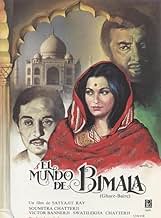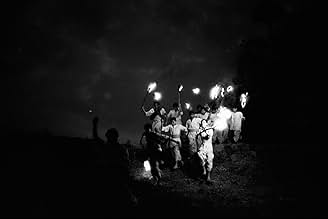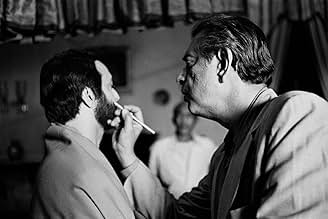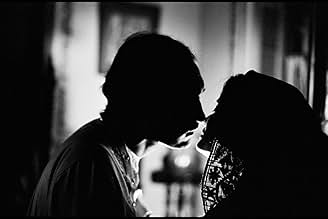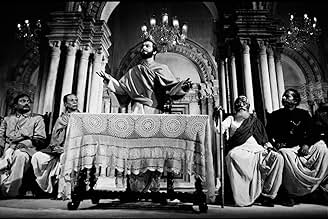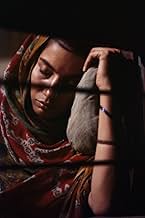IMDb RATING
7.5/10
2K
YOUR RATING
A landowner's wife emerges from seclusion through education, defying social norms. Her newfound freedom leads to political awakening when her husband's old friend brings revolutionary ideas ... Read allA landowner's wife emerges from seclusion through education, defying social norms. Her newfound freedom leads to political awakening when her husband's old friend brings revolutionary ideas to their door.A landowner's wife emerges from seclusion through education, defying social norms. Her newfound freedom leads to political awakening when her husband's old friend brings revolutionary ideas to their door.
- Director
- Writers
- Stars
- Awards
- 3 wins & 2 nominations total
Soumitra Chatterjee
- Sandip Mukherjee
- (as Soumitra Chattopadhyay)
Swatilekha Sengupta
- Bimala Choudhury
- (as Swatilekha Chattopadhyay)
Jennifer Kendal
- Miss Gilby
- (as Jennifer Kapoor)
Bimala Chatterjee
- Kulada
- (as Bimal Chattopadhyay)
- Director
- Writers
- All cast & crew
- Production, box office & more at IMDbPro
Featured reviews
Here is one more film made our of the work of Tagore. The great Kishore Kumar gave his voice for a song in this film. The worst script adapted by Ray I think. It always bugged me how the entire story was converted to a play and the film was made plainly out of it. The story it interesting though - it shows how the 'boycott British product' movement in early 1900s impacted poor people in our country.
Read about the great Indian debate between Gandhi and Tagore before watching this movie.
You can see Gandhi in the character of Sandip and Tagore in the character of Nikhil.
Now watch this movie. An absolute masterpiece
"Dear me, I had no conception that the lower classes had such white skins." - Lord Curzon
Set in the early 1900s, Satyajit Ray's "The Home and the World" features the recollections of Bimala Cloudhury (Swatilekha Chatterjee), the wife of Nikhilesh (Victor Banerjee), a wealthy Bengal merchant. As her spouse encourages her to adopt Western attitudes, Bimala begins to drift away from traditional social and religious values.
By "Home's" second act, it becomes clear that Nikhilesh idolises India's British rulers, who, under the leadership of Lord Curzon, have begun partitioning the Muslim and Hindu populations of Bengal. Ironically, Nikhilesh's desires for Bimala to be "reeducated" have the opposite effect; she's drawn toward a leader of the Swadeshi, a nationalist movement. Indeed, Bimala becomes the movement's first female member.
"Home" thus sketches an India in which forces have begun pulling in opposing directions. Throughout the film, traditional values vie with liberated modernism. This "modernism", ironically, is introduced via the "primitive" hand of British Imperialism, which is itself opposed by an Indian Nationalism whose progressivism not only masks reactionary elements, but points to the eventual disharmony between Hindus and Muslims.
Slow, subtle, and set almost entirely indoors, "The Home and the World" heavily resembles the works of Luchuno Visconti. Like Visconti at his best, Ray's film portrays a society on the cusp of transformation. Bimala's plight, torn between two men, itself echoes the upheaval's of her nation.
8/10 – See "North West Frontier".
Set in the early 1900s, Satyajit Ray's "The Home and the World" features the recollections of Bimala Cloudhury (Swatilekha Chatterjee), the wife of Nikhilesh (Victor Banerjee), a wealthy Bengal merchant. As her spouse encourages her to adopt Western attitudes, Bimala begins to drift away from traditional social and religious values.
By "Home's" second act, it becomes clear that Nikhilesh idolises India's British rulers, who, under the leadership of Lord Curzon, have begun partitioning the Muslim and Hindu populations of Bengal. Ironically, Nikhilesh's desires for Bimala to be "reeducated" have the opposite effect; she's drawn toward a leader of the Swadeshi, a nationalist movement. Indeed, Bimala becomes the movement's first female member.
"Home" thus sketches an India in which forces have begun pulling in opposing directions. Throughout the film, traditional values vie with liberated modernism. This "modernism", ironically, is introduced via the "primitive" hand of British Imperialism, which is itself opposed by an Indian Nationalism whose progressivism not only masks reactionary elements, but points to the eventual disharmony between Hindus and Muslims.
Slow, subtle, and set almost entirely indoors, "The Home and the World" heavily resembles the works of Luchuno Visconti. Like Visconti at his best, Ray's film portrays a society on the cusp of transformation. Bimala's plight, torn between two men, itself echoes the upheaval's of her nation.
8/10 – See "North West Frontier".
The movie is played with a flashback, with a womans voice over. She is describing her life and her experiences. She is Bimala, the wife of Nikhilesh, a landlord and ruler of an area in West Bengal. She was married to him at a very early age. Bimala recollects how her husband helped her discover her true self, her dreams , aspirations and how she came to understand the meaning of life and love.
Nikhilesh(Victor Bannerjee , in a class act) , is Rajababu of a province. His people look upto him , and he is benevolent in his demeanour with them. He marries Bimala , but due to the prevalent child marriage traditions , there is a significant age gap between the two. Nikhilesh encourages his wife to explore a life beyond the mundane. He treats her as an equal rather than a submissive partner. Bimala takes English lessons (Jennifer Kendal Kapoor in a cameo) on Nikhilesh's insistence. Gradually as Nikhilesh encourages her to expand her horizons, she becomes more confident. Then enters Sandeep , a revolutionary and Nikhilesh's good friend. Sandeep and Nikhilesh are contrasting personalities. Nikhilesh is silent to Sandeep's vitriolic temperament. Sandeep talks of high ideals, while Nikhilesh thinks about the ground realities. A wonderful sequence where Sandeep is advocating boycott of English goods, while Nikhilesh differs , saying that the poor traders would be affected the most, not so much the English Saab. Bimala is swayed by Sandeep's idealistic words and admires him. Nikhilesh notices the same, when she doesn't take sides, but doesn't comment. Gradually the chemistry between Bimala and Sandeep increases, and while Nikhilesh is aware of it, he defends his silence to Bimala by saying that how will he come to know how much she values him, unless she does not compare his positives and negatives with anyone else. Suddenly a series of incidents show Bimala, a side of Sandeep , that she had not envisioned. During the course of these events she realises the true meaning of Nikhilesh's words to her , and during 'that' heated discussion which he and Sandeep had. While Nikhilesh is hurt by the change in Bimala's behaviour ,he says not a word. Slowly Bimala comes to know that the love respect admiration that she had read in books, was actually Nikhilesh's feelings towards her. How, he treated her as his equal (which in those days was unheard of), broadened her outlook towards life as a whole. Nikhilesh has a heart to heart talk with Bimala ,and drives out to face a riot in the village, while the law catches up with Sandeep. Bimala is left to reminisce all the events, it sums up the movie.
Nikhilesh(Victor Bannerjee , in a class act) , is Rajababu of a province. His people look upto him , and he is benevolent in his demeanour with them. He marries Bimala , but due to the prevalent child marriage traditions , there is a significant age gap between the two. Nikhilesh encourages his wife to explore a life beyond the mundane. He treats her as an equal rather than a submissive partner. Bimala takes English lessons (Jennifer Kendal Kapoor in a cameo) on Nikhilesh's insistence. Gradually as Nikhilesh encourages her to expand her horizons, she becomes more confident. Then enters Sandeep , a revolutionary and Nikhilesh's good friend. Sandeep and Nikhilesh are contrasting personalities. Nikhilesh is silent to Sandeep's vitriolic temperament. Sandeep talks of high ideals, while Nikhilesh thinks about the ground realities. A wonderful sequence where Sandeep is advocating boycott of English goods, while Nikhilesh differs , saying that the poor traders would be affected the most, not so much the English Saab. Bimala is swayed by Sandeep's idealistic words and admires him. Nikhilesh notices the same, when she doesn't take sides, but doesn't comment. Gradually the chemistry between Bimala and Sandeep increases, and while Nikhilesh is aware of it, he defends his silence to Bimala by saying that how will he come to know how much she values him, unless she does not compare his positives and negatives with anyone else. Suddenly a series of incidents show Bimala, a side of Sandeep , that she had not envisioned. During the course of these events she realises the true meaning of Nikhilesh's words to her , and during 'that' heated discussion which he and Sandeep had. While Nikhilesh is hurt by the change in Bimala's behaviour ,he says not a word. Slowly Bimala comes to know that the love respect admiration that she had read in books, was actually Nikhilesh's feelings towards her. How, he treated her as his equal (which in those days was unheard of), broadened her outlook towards life as a whole. Nikhilesh has a heart to heart talk with Bimala ,and drives out to face a riot in the village, while the law catches up with Sandeep. Bimala is left to reminisce all the events, it sums up the movie.
"The Home & The World" ( 1984) is based on a novel written by Rabindranath Tagore. It is a simple story of two friends, their friendship & love. Victor Bannerjee plays Nikhilesh, the maharaja while his friend's role is done by Soumitra Chatterjee who was former's class mate. The latter joins the maharaja to promote his political career. Maharaj's wife Bimala Chaudhury( Swatilekha Sengupta) develops a liking for him owing to his persuasive & impressive language. They get amorously involved. The story is reminiscent of Ray's earlier film made way back in 1964 titled " Charulata" featuring Soumitra Chatterjee, Syamal Ghosal, & Madhabi Mukherjee. Many things were common in both films. Both were based on stories by Rabindranath Tagore, the Noble laureate. Both films revolves round a childless married woman who falls for a persuasive speaking visitor, Saumitra Chatterjee ,while her husband watches the scene from the side lines as a passive spectators. In the later film the woman ,who was earlier confined to her 'palace chamber', gets an opportunity to meet the visitor & supports his 'swadeshi movement', too, despite her husband's disapproval. She even steals gold coins from the safe to lend a supporting hand .The film was made on a lavish canvass & it is very difficult to present each aspect or scene here. However, I tried to part with reasonably good information to readers. Interestingly, in both the films the woman returns to her husband .
Did you know
- TriviaBased on the book "Ghare-Baire" by Rabindranath Tagore. Director Satyajit Ray had previously written a screenplay from this book, but had sold the rights to a group who never filmed the story. 30 years later, Ray rewrote the screenplay for this film.
- ConnectionsReferenced in Z Channel, une magnifique obsession (2004)
- How long is The Home and the World?Powered by Alexa
Details
- Release date
- Country of origin
- Languages
- Also known as
- The Home and the World
- Filming locations
- Tollygunj, Kolkata, India(Studio Set)
- Production company
- See more company credits at IMDbPro
Box office
- Gross worldwide
- $6,951
- Runtime2 hours 20 minutes
- Sound mix
Contribute to this page
Suggest an edit or add missing content


